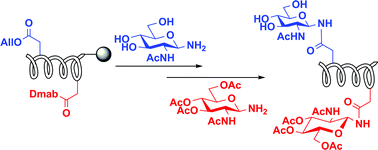Synthesis of N-linked glycopeptidesvia solid-phase aspartylation†
Abstract
An efficient strategy for the preparation of

* Corresponding authors
a
School of Chemistry, The University of Sydney, NSW 2006, AUSTRALIA
E-mail:
richard.payne@sydney.edu.au
Fax: +61 2 9351 3329
Tel: :+61 2 9351 5877
An efficient strategy for the preparation of

 Please wait while we load your content...
Something went wrong. Try again?
Please wait while we load your content...
Something went wrong. Try again?
T. Conroy, K. A. Jolliffe and R. J. Payne, Org. Biomol. Chem., 2010, 8, 3723 DOI: 10.1039/C003673K
To request permission to reproduce material from this article, please go to the Copyright Clearance Center request page.
If you are an author contributing to an RSC publication, you do not need to request permission provided correct acknowledgement is given.
If you are the author of this article, you do not need to request permission to reproduce figures and diagrams provided correct acknowledgement is given. If you want to reproduce the whole article in a third-party publication (excluding your thesis/dissertation for which permission is not required) please go to the Copyright Clearance Center request page.
Read more about how to correctly acknowledge RSC content.
 Fetching data from CrossRef.
Fetching data from CrossRef.
This may take some time to load.
Loading related content
